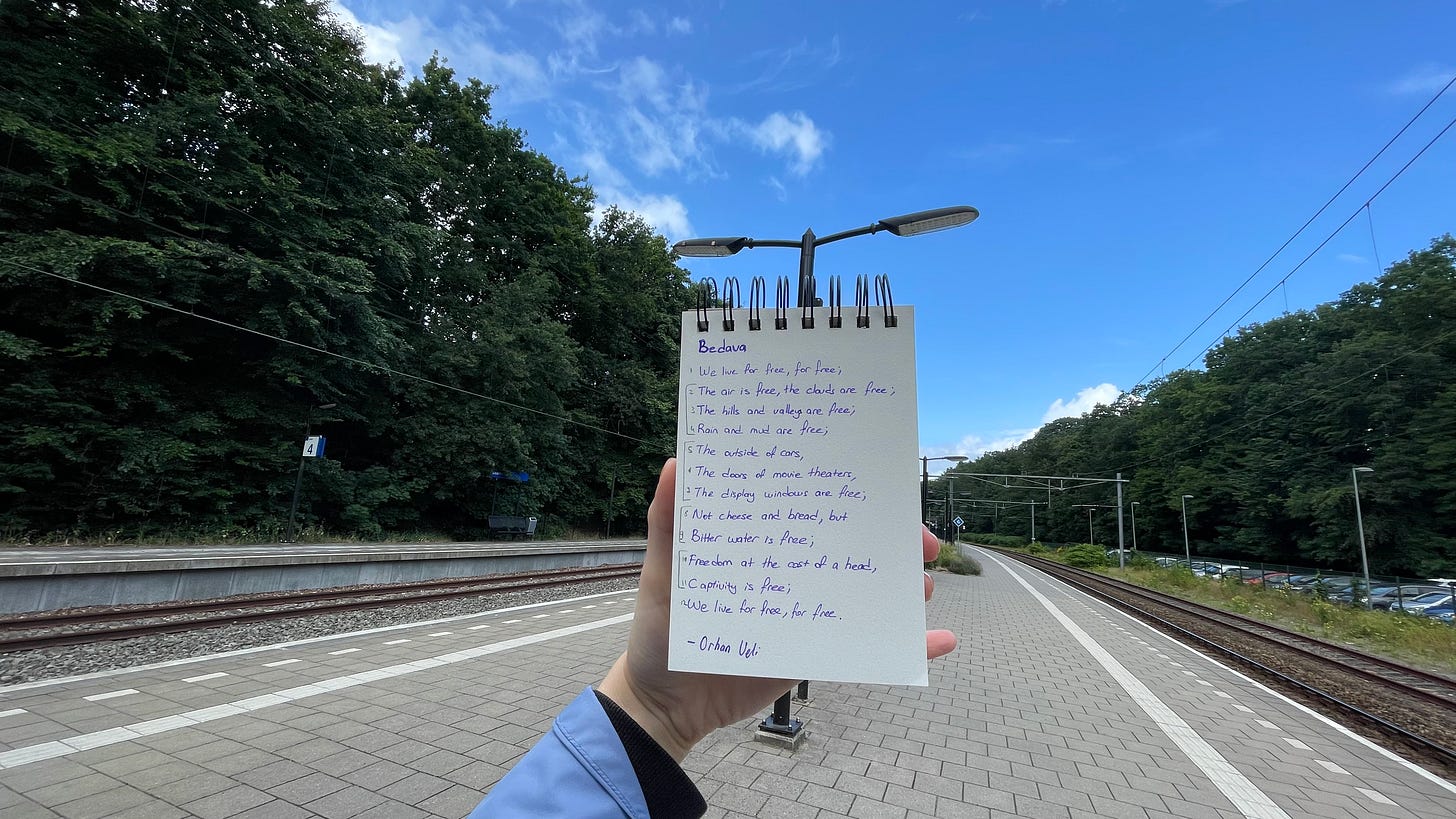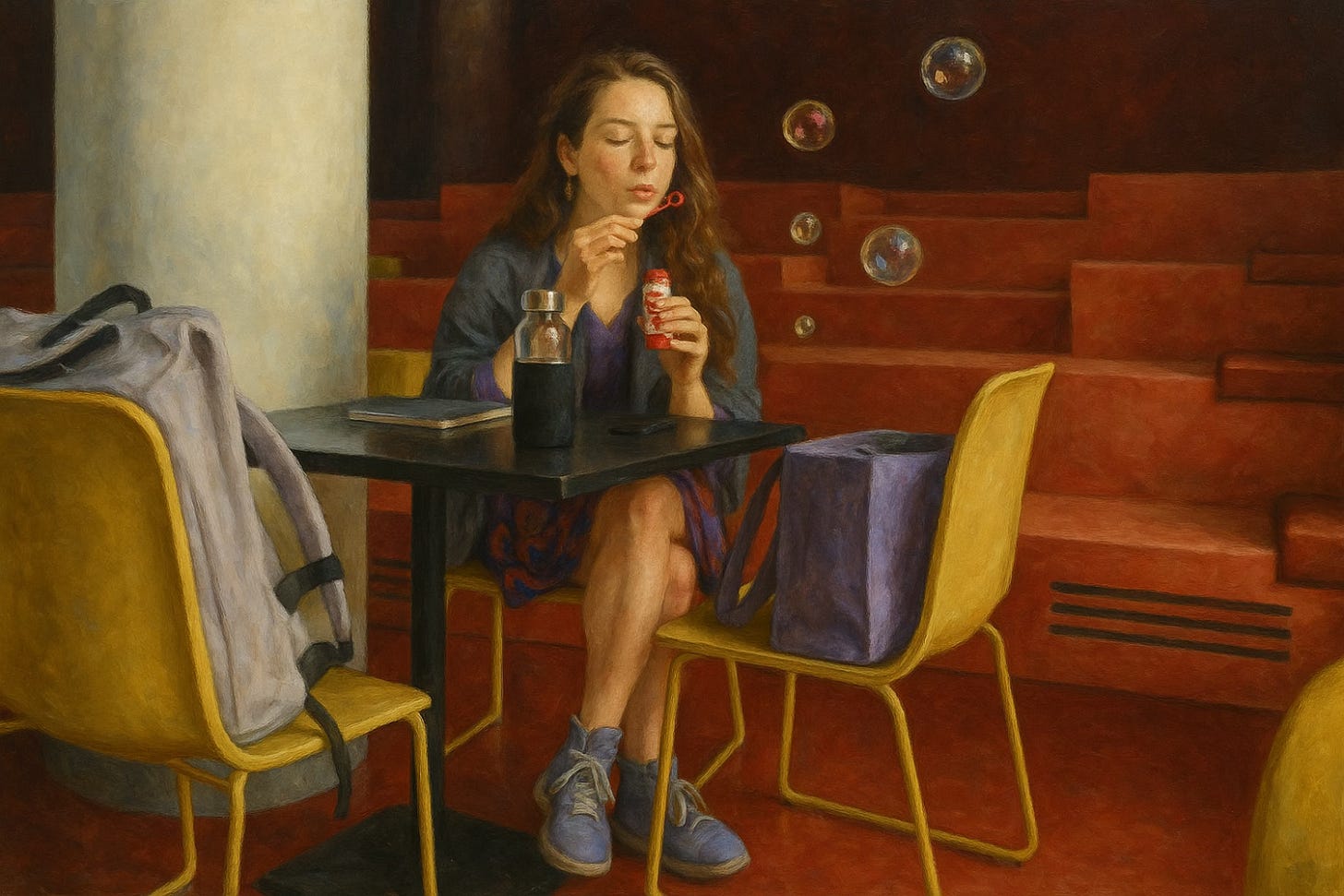This is a part of my creative diary for anyone curious about how to build poetic, cinematic scenes as a human in the loop!
AI Film Bedava was created using Moonvalley’s video model Marey 1.5 during the early testing phase as an Alpha Tester.
Marey prioritizes training exclusively on licensed data from creators which marks an interesting shift in how generative AI tools are developed in Summer 2025.
Let’s break down this for anyone trying to create with AI more intentionally.
🪡 Why did I use a poem?
Storytelling is often the hardest part of AI Filmmaking. It takes years (sometimes decades) to become a strong storyteller. A poem already gives you rhythm, tone, structure and metaphor.
That’s why using a public domain poem is such a powerful place to begin.
I used Orhan Veli’s “Bedava” (“For Free”) an amazing poem that contrasts: abundance and restriction, joy and melancholy, irony and truth.
All within deceptively simple sentences, it’s amazing.
Getting Started
1. Find a poem you love.
Make sure it’s in the public domain, in most countries, this means the poet must have passed away at least 70 years ago. Orhan Veli passed in 1950, which makes Bedava available.
You’re co-creating with a poet who left you a message across time :)
How cool is that?!?
2. Make an AI film between 42 and 62 seconds.
This gives you a tangible boundary to experiment within.
It’s long enough to “say something” and short enough to finish.
My 7 Production Steps
We built this film through an iterative conversation between human and non-human. Here's how the process unfolded and how you might try it, too.
(I will summarize 105 pages PDF and hours of production, please try to focus)
Step 0: Take a short trip
Before generating with any AI tools, I read the poem many times, write it with pen and paper. I went outside and think about what each line felt like visually.
I sketched ideas to see something.
Visual thinking starts before prompting.
Step 1: Give the poem to the AI (not everything!)
I started by sharing the full poem with an LLM and asking for detailed visual prompts without giving it my own notes or ideas yet. I wanted to see what it saw.
I call this the initial point. You don’t expect the “prompt” to give you a beginning.
You’re trying to understand where the model naturally starts: what it notices, what it chooses to visualize first.
Step 2: Think out loud and strategize together
After seeing the initial point, I shared my notes. This is the moment co-creation began like a co-director I express my vision to.
We strategized two version:
✅ Main prompt (core consistent wording)
✳️ Alternate prompt (testing composition wording and structure)
main prompt example: “A woman with dark hair wearing a flowing linen dress, walking in a wide open valley at sunrise. In the foreground: wildflowers and soft mud. In the middle ground: the woman walking. In the background: distant hills under a glowing sky. Cinematic lighting, soft natural colors, realistic textures”
alternate prompt example: “green valley surrounded by sunlit hills. A barefoot woman in a soft beige dress walks along a narrow dirt path through the middle of the frame. The foreground shows textured grass and natural earth. In the distance, the hills stretch far under a soft blue sky. Light is soft and warm. The scene feels open, slow and contemplative. Slightly elevated camera angle, painterly realism” (see below)
Character Design (woman)
Environment Design (valley / Dutch city / indoor scenes)
Lighting + Color Palette: Soft cinematic lighting, natural colors, painterly texture, shallow depth of field, Daylight (Golden sunrise → Soft midday overcast → Golden sunset)
Framing (use of foreground, middle ground, background)
Tone (soft realism with hints of surrealism, painterly textures)
We generate the visual plan, visual tone board and how we wanted the story to flow.
This is how you build vision with AI, not for it.
Step 3: Finalize the visual tone board
Real work happened in the invisible layer: constructed detailed visual prompts to make them feel belong the same world and stayed open to what AI may generate.
Since Marey doesn’t know about the LLM context, the phrase “same woman” doesn’t makes sense. It is important to use similar words to create similar look and feel.
We had to repeat her full description every time to get visual consistency.
We also tested two prompts per scene (a main version and an alternate version) to see what kind of phrasing produced better consistency, mood and framing.
🎬 SCENE 1: “We live for free, for free.”
Sunrise, valley, walking woman
✅ MAIN PROMPT - SCENE 1A
A woman with shoulder-length black hair, wearing a light beige linen dress with long sleeves, barefoot, walking slowly through a wide open valley at sunrise. In the foreground: soft wild grass and small yellow wildflowers. In the middle ground: the woman walking from left to right with calm expression. In the background: gentle rolling hills glowing in golden sunlight under a soft misty sky. Cinematic lighting, painterly texture, warm earthy tones, realistic depth
✳️ TWEAKED PROMPT – SCENE 1B (test version)
A valley scene at sunrise. A barefoot woman in a beige linen dress walks across the middle of the frame, her dark hair moving gently in the breeze. In front: grass and flowers sway softly. Behind her, low hills stretch into the golden distance. The scene is lit with natural golden morning light. Wide angle, poetic mood, realistic textures, soft composition.
🎬 SCENE 2: “The air is free, the clouds are free.”
Same woman reaching skyward, air/cloud motif
✅ MAIN PROMPT – SCENE 2A
A woman with shoulder-length black hair, wearing a light beige linen dress with long sleeves, barefoot, standing still in a wide valley. She raises both arms toward the sky as soft clouds drift above her. In the foreground: wildflowers and short grass catching light wind. In the middle ground: the woman with arms open, looking up. In the background: light blue sky with soft, slow-moving clouds above distant hills. Soft cinematic lighting, painterly texture, natural colors, peaceful atmosphere
✳️ TWEAKED PROMPT – SCENE 2B (test version)
A woman stands in the center of a valley, barefoot, in a flowing beige dress. Her arms are reaching toward the sky as clouds float above. Wind moves through the field around her. The background shows low hills and a pale blue morning sky. The scene feels calm, dreamlike and full of air. Shot with a medium-wide lens, natural lighting, minimal surrealism
Step 4: Generate the scenes
One scene per line of the poem. I didn’t generate and move on. I generated and documented what broke the style, what helped hold it together.
We structured every prompt with:
Foreground / Middle ground / Background
Light and tone language
Composition logic
Emotional clarity
Step 5: Think about sound design
Sound is half the experience and in AI filmmaking, it’s often overlooked.
I recorded myself reading the poem in my wardrobe and layered ambient textures using Audacity and sounds with Creative Commons 0 license.
I used:
This film needed presence. A bit of noise reduction, some amplification and simple fade-ins and fade-outs made it so much better.
Step 6: Edit
I didn’t rush, I watched the scenes again after a night of sleep.
I let each moment linger, like a line in a poem.
Step 7: Premiere
In my case, I’m releasing this AI Film: Bedava (For Free) by Orhan Veli Kanık as part of this article.
You can share your version however you like:
Host a small screening with friends
Share it silently online without explaining
Archive it for yourself or digital heritage for your children
The poem gave me an experience.
Co-Creation with AI
Even though we call it “AI generated” that’s not the whole truth.
Nothing comes from nothing.
You guide, curate, direct, refine as a human in the loop.
This is co-creation and it's a form of self-expression.
My Hope is…
AI filmmaking can help us understand each other better.
We don’t have to agree, we can hear each other.
💰 What would be the production budget for this film?
This AI film cost $70 to make. I generated 45 scenes and used 13 in the final cut.
In a “real world” setting that wouldn’t even cover coffee and cookies.
Of course, it still cost time, effort and creative care. The fact that this level of visual consistency and storytelling can be achieved solo is something worth pausing on.
Treating a project like a “real film” with a budget, production steps and intention can help bring it to completion.
That framing makes a difference.
What Poem Would You Film?
Thanks for reading. You might enjoy: Prompt Strategies for Creative Work
If you try this yourself, I’d love to see what you make.
Have a nice day :)
Ayça Turan
ayca.tech
Baarn, the Netherlands
July 2025
Final Takeaways:
Use a poem or strong narrative seed.
Test prompt variations early.
Repeat detailed visual descriptions if necessary.
Build a visual tone board for light, color and composition.
Let AI surprise you, don’t over-correct.
Sleep between stages, let the project evolve naturally.
Celebrate the niche! AI allows deeply personal films to exist.







